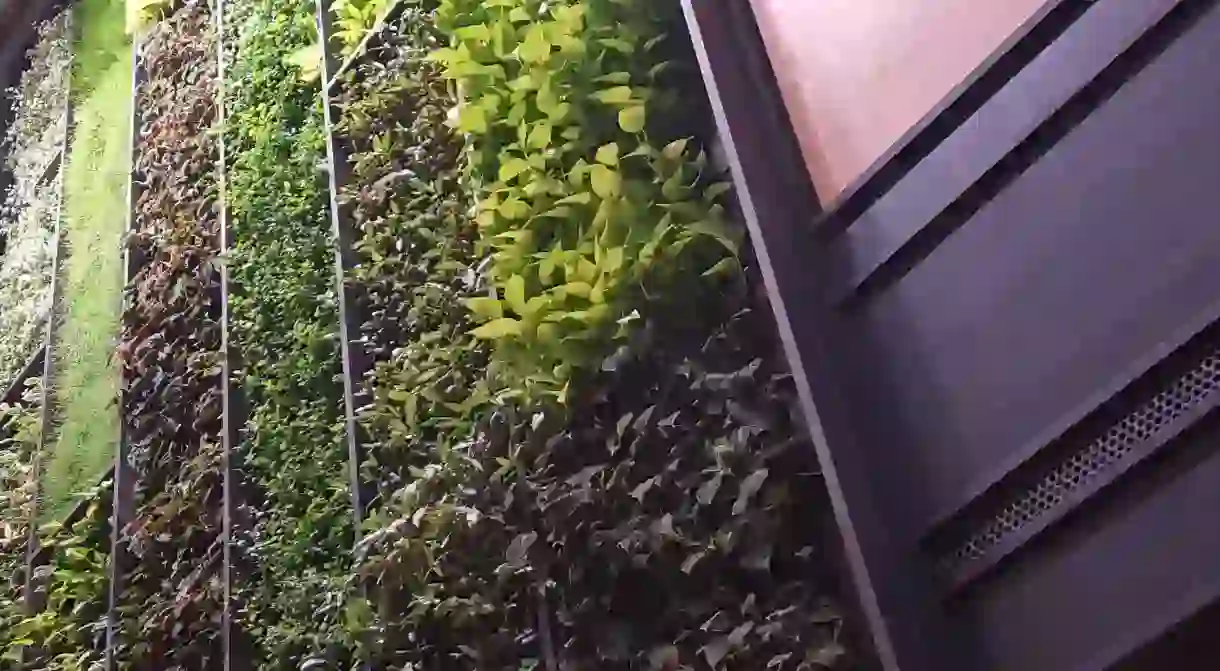How to Make a DIY Plant Wall

Are green “plant walls” the new eco-conscious home art? Here’s how you can make your own…

New York City-based designer and project manager at Future Green Studios, Max Cohen, shares his tips on ways to create a green wall in the home, including the best plants to use and ways to nurture your DIY creation.
Types of plants to use for a plant wall

Low maintenance plants that require low-light and minimal water normally work well for plant walls. “There are a variety of mosses, lichens, and air plants which offer different textures and shades of green that perform in low light conditions with little maintenance,” says Cohen. Here are his preferred plants:
Preserved reindeer moss. Belonging to the lichen family and originating from the alpine tundra, preserved reindeer moss comes in a variety of shades and is readily available in craft and construction stores. “The small clumps of the lichen can be glued or tacked to a backing of wood, plastic, or metal.”
Spanish moss. This plant derives its nutrients from the air, and can normally be found hanging from trees in the American South. “Spanish moss can be purchased in bag form [at a local craft and box construction store] and applied to an interior green wall.”

Sheet moss and clump moss. “Typically seen in shady woodlands, these mosses grow on bark or soil and come in thousands of varieties of colors and textures.” While they do require watering and/or misting, Cohen says they “have a fantastic presence in the home terrarium or green wall.”
Air plants. “Air plants are epiphytes from the bromeliad family. As you might expect, these plants extract their nutrients from the air [and come] in hundreds of sizes, colors, and textures. They are available from boutique garden stores and online…can be hung or pocketed in green walls and require an occasional misting.” They’re best used to add a sense of depth and flair on a green wall or inside a terrarium.

How to care for your new green wall, according to Cohen
• Light and water are essential to the survival of plants.
• Understanding the light conditions of the environment where you will be placing the plants is critical. In low light conditions, additional grow lights may be added to expand the range of plants that will survive. The amount of light exposure will impact the plant growth and may also change the watering requirements.
• Water can be added with a watering can or hand mister. When designing a green wall or terrarium, it is important to place plants with similar watering requirements in the same zone. Understanding the specific plants and keeping an eye on moisture levels will help keep the plants happy.
• Many air plants will benefit from a leaf cleaning, [especially] if they are in an environment that tends to accumulate dust.

Ways to create a green wall in small urban spaces
Framed green wall panel: “Fixing moss, air plants, and lichens to a wood, plastic, or metal backing is a great way to create a green panel that can be hung on a wall. The plants can be fixed to the panel with a glue, spray adhesive, or tacked in with small nails or screws. Adding a frame to the panel hides the edges and gives the green wall a clean, finished look. Adding a layer of waterproofing or plastic to the back of the panel may help to protect the wall behind,” says Max Cohen.
Terrarium: “Adding plants, soil, and rocks to a glass enclosure can create a charming focal point in a room. Terrariums create a humid environment that many plants will thrive in. The addition of soil to the environment allows for the growth of ferns and orchids, in addition to the mosses, lichens, and air plants. Terrariums can be purchased online or constructed out of an old fish tank or glassware.”

Hanging glass globes or framed air plants: “Air plants can be hung in glass globes or woven into metal frames that can be hung from a wall or in a window. These frames are lightweight and allow for the plants to receiving maximum light. The plants can be misted in place or soaked and replaced, depending on the location.”
Potted plants: “More traditional potted indoor plants and be arranged on shelves or a metal framework to create interesting patterns. The pots can also be hung from a cabled or rope with trailing vines or perennials to create a hanging garden near a window.”














